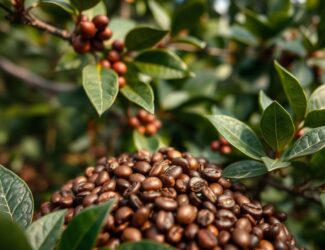
Coffee Prices Surge as Vietnamese Farmers Embrace Durian Trend
Vietnam, known as the world’s second-largest producer of coffee beans and the largest robusta producer, is experiencing a significant shift in its agricultural landscape. Coffee farmers are increasingly turning their attention away from coffee cultivation and toward durian farming. This transition has implications for both the coffee industry and the global market.
Durian, often referred to as “the king of fruits,” has gained immense popularity in China in recent years. Its thorny appearance, sweet taste, and pungent odor have made it a sought-after delicacy. Vietnamese exports of durian to China exceeded $2 billion in 2023, a staggering fivefold increase from the previous year. This growth trend is expected to continue.
The allure of durian has led many Vietnamese farmers to switch from coffee to durian cultivation. As a result, the area available for coffee plants has decreased, impacting coffee supply. Coffee thrives in tropical climates, but deforestation and land scarcity have made it increasingly difficult to find suitable areas for coffee farming.
Additionally, Vietnam faces a supply crunch due to the El Nino weather phenomenon, which has caused droughts in Southeast Asia. The scorching heat and insufficient water have hindered coffee plant growth, affecting overall production.
Robusta coffee futures in London reached a new high in late April, surpassing $4,500 per tonne. Although prices have cooled somewhat since then, they remain significantly higher than at the end of the previous year. Robusta beans, commonly used in instant coffee, have become more attractive to roasters and consumers seeking cost-effective options amid high inflation.
Several structural factors contribute to the changing landscape:
- Shift from Arabica to Robusta: Major European and U.S. companies are shifting away from the high-end Arabica coffee variety (mostly produced in Central and South America) in favor of the relatively inexpensive robusta. Rising transportation and fuel costs play a role in this shift.
- Rising Consumption in Asia: From October 2022 to September 2023, consumption in the Asia-Pacific region totaled 44.5 million bags, accounting for over one-quarter of the world’s total coffee consumption. This represents a 12% increase over the previous four years.
Despite these challenges, coffee remains deeply ingrained in Vietnamese culture. It’s a common sight to see people of all ages sitting and chatting over coffee on the sidewalks. While Vietnam began growing coffee during the French colonial period in the 19th century, its popularity surged in the 1980s as the country’s economy developed.
Local demand for high-quality beans has risen alongside the proliferation of coffee shops, including global chains like Starbucks. However, the allure of durian and the changing economic landscape continue to shape Vietnam’s agricultural priorities



